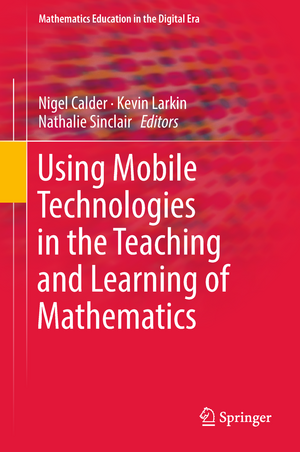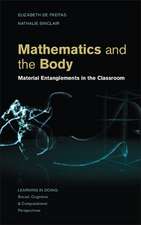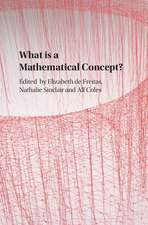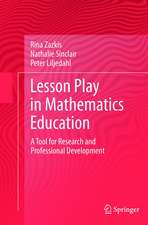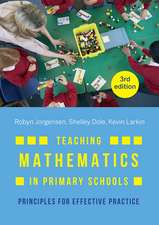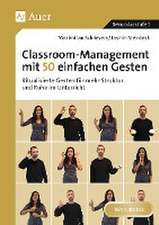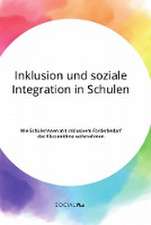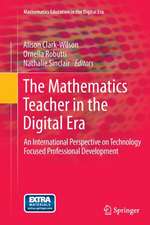Using Mobile Technologies in the Teaching and Learning of Mathematics: Mathematics Education in the Digital Era, cartea 12
Editat de Nigel Calder, Kevin Larkin, Nathalie Sinclairen Limba Engleză Hardback – 17 aug 2018
This volume draws upon international research and reports on a range of research projects that have incorporated mobile technologies for mathematics education. It presents research on the use of mobile technologies, such as iPads, iPods, iPhones, Androids,and Tablets, across a diverse range of cultures, year levels and contexts. It examines the ways in which mobile technologies, including apps, might influence students’ engagement, cognition, collaboration and attitudes, through the reshaping of the learning experience. In addition, the book presents appropriate ways to integrate mobile technologies into teaching and learning programmes.
It is a significant reference book for those involved with teaching mathematics or using mobile technologies in education, while also offering insights and examples that are applicable to the use of digital technologies in education generally.
| Toate formatele și edițiile | Preț | Express |
|---|---|---|
| Paperback (1) | 946.24 lei 43-57 zile | |
| Springer International Publishing – 19 ian 2019 | 946.24 lei 43-57 zile | |
| Hardback (1) | 952.26 lei 43-57 zile | |
| Springer International Publishing – 17 aug 2018 | 952.26 lei 43-57 zile |
Din seria Mathematics Education in the Digital Era
- 15%
 Preț: 642.68 lei
Preț: 642.68 lei - 24%
 Preț: 739.44 lei
Preț: 739.44 lei - 18%
 Preț: 782.42 lei
Preț: 782.42 lei - 15%
 Preț: 644.82 lei
Preț: 644.82 lei - 18%
 Preț: 1127.15 lei
Preț: 1127.15 lei - 18%
 Preț: 959.36 lei
Preț: 959.36 lei - 24%
 Preț: 804.93 lei
Preț: 804.93 lei - 18%
 Preț: 990.93 lei
Preț: 990.93 lei -
 Preț: 438.10 lei
Preț: 438.10 lei - 18%
 Preț: 953.03 lei
Preț: 953.03 lei - 18%
 Preț: 889.92 lei
Preț: 889.92 lei - 24%
 Preț: 875.83 lei
Preț: 875.83 lei - 24%
 Preț: 752.35 lei
Preț: 752.35 lei -
 Preț: 360.15 lei
Preț: 360.15 lei - 15%
 Preț: 649.06 lei
Preț: 649.06 lei - 20%
 Preț: 573.77 lei
Preț: 573.77 lei -
 Preț: 394.29 lei
Preț: 394.29 lei -
 Preț: 389.88 lei
Preț: 389.88 lei - 15%
 Preț: 649.54 lei
Preț: 649.54 lei - 18%
 Preț: 1117.50 lei
Preț: 1117.50 lei - 18%
 Preț: 1112.78 lei
Preț: 1112.78 lei
Preț: 952.26 lei
Preț vechi: 1161.29 lei
-18% Nou
Puncte Express: 1428
Preț estimativ în valută:
182.24€ • 189.56$ • 150.45£
182.24€ • 189.56$ • 150.45£
Carte tipărită la comandă
Livrare economică 14-28 aprilie
Preluare comenzi: 021 569.72.76
Specificații
ISBN-13: 9783319901787
ISBN-10: 3319901788
Pagini: 336
Ilustrații: VII, 323 p. 84 illus., 54 illus. in color.
Dimensiuni: 155 x 235 mm
Greutate: 0.64 kg
Ediția:1st ed. 2018
Editura: Springer International Publishing
Colecția Springer
Seria Mathematics Education in the Digital Era
Locul publicării:Cham, Switzerland
ISBN-10: 3319901788
Pagini: 336
Ilustrații: VII, 323 p. 84 illus., 54 illus. in color.
Dimensiuni: 155 x 235 mm
Greutate: 0.64 kg
Ediția:1st ed. 2018
Editura: Springer International Publishing
Colecția Springer
Seria Mathematics Education in the Digital Era
Locul publicării:Cham, Switzerland
Cuprins
01. Introduction.- 02. Mobile Technologies: How might using mobile technologies reshape the learning and teaching of mathematics? Nigel Calder, Kevin Larson and Nathalie Sinclair.- Section One: Looking across the terrain.- 03. Mathematics apps - stormy with the weather clearing: Using cluster analysis to enhance app use in mathematics classrooms. Kevin Larkin and Todd Milford.- 04. How might apps reshape the mathematical learning experience? Nigel Calder and Carol Murphy.- 05. Mobile technologies in the primary mathematics classroom: Engaging or not? Catherine Attard.- Section Two: Traversing the teaching and learning landscape.- 06. When robot A.L.E.X. trains teachers how to teach mathematics. Andreas Kyriakides and Maria Meletiou-Mavrotheris.- 07. Supporting teachers’ orchestration of mobile learning activities. Håkan Sollervall, Didac Gil de la Iglesia and Janosch Zbick.- 08. Collaborative engagement through mobile technology in mathematics learning. Mina Sedaghatjou and Sheree Rodney.- 09. Augmenting mathematics with mobile technology. Christian Bokhove, Alison Clark-Wilson and Marios Pittalis.- Section Three: Navigating content: Focussing on particular concepts.- 10. Developing mastery of time concepts by integrating lessons and apps. Timothy Pelton, Todd Milford and Lesley Francis Pelton.- 11. Heatmap and hierarchical clustering analysis to highlight changes in young children’s developmental progressions using virtual manipulative mathematics apps. Christina W. Lommatsch, Stephen Tucker, Patricia Moyer-Packenham and Jürgen Symanzik.- 12. A better story: An embodied-design argument for generic manipulatives. Dana Rosen, Alik Palatnik, and Dor Abrahamson.- 13. Fingers-on geometry: The emergence of symmetry in a primary school classroom with multi-touch dynamic geometry. Sean Chorney and Nathalie Sinclair.- 14. Touching numbers and feeling quantities: Methodological dimensions of working with TouchCounts. Francesca Ferrara and Ketty Savioli.- 15. Approaching secondary school geometry through the logic of inquiry within technological environments. Carlotta Soldano and Ferdinando Arzarello.- Section Four: Exploring new forms of communication to make mathematical learning visible.- 16. Mathematics screencasts for teaching and learning. Linda Galligan and Carola Hobohm.- 17. The use of mobile technologies in the primary school mathematics classroom- developing ‘create-alouds’. Anne Prescott and Damian Maher.- 18. Using Show and Tell apps to engage students in problem solving in the mathematics classroom. Naomi Ingram, Keryn Pratt, and Sandra Williamson-Leadley.
Textul de pe ultima copertă
Mobile technologies influence the way that we interact with the world, the way that we live. We use them for communication, entertainment, information and research. In education settings, there has been substantial investment in mobile devices, often without a concomitant investment in developing pedagogy and practices. With mobile technologies evolving rapidly, and the number of educational apps growing, there is a need for research into how they facilitate mathematics learning. Such research is of particular importance regarding how such devices may be used to open up new ways of envisaging mathematics and mathematics education, and to help develop conceptual rather than procedural or declarative knowledge.
This volume draws upon international research and reports on a range of research projects that have incorporated mobile technologies for mathematics education. It presents research on the use of mobile technologies, such as iPads, iPods, iPhones, Androids, and Tablets, across a diverse range of cultures, year levels and contexts. It examines the ways in which mobile technologies, including apps, might influence students’ engagement, cognition, collaboration and attitudes, through the reshaping of the learning experience. In addition, the book presents appropriate ways to integrate mobile technologies into teaching and learning programmes.
It is a significant reference book for those involved with teaching mathematics or using mobile technologies in education, while also offering insights and examples that are applicable to the use of digital technologies in education generally.
This volume draws upon international research and reports on a range of research projects that have incorporated mobile technologies for mathematics education. It presents research on the use of mobile technologies, such as iPads, iPods, iPhones, Androids, and Tablets, across a diverse range of cultures, year levels and contexts. It examines the ways in which mobile technologies, including apps, might influence students’ engagement, cognition, collaboration and attitudes, through the reshaping of the learning experience. In addition, the book presents appropriate ways to integrate mobile technologies into teaching and learning programmes.
It is a significant reference book for those involved with teaching mathematics or using mobile technologies in education, while also offering insights and examples that are applicable to the use of digital technologies in education generally.
Caracteristici
Examines new processes and learning that are afforded by mobile technologies, including apps that have screen-casting and augmented reality features Considers the use, quality and impact of mathematics apps and games Draws upon international research on the use of mobile technologies in a diverse range of educative settings Fills the gap in the literature on the use of mobile technologies in the teaching and learning of mathematics
